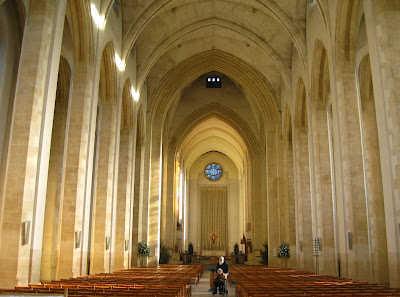Up close it is a much more imposing building. It is, as you can see, modern, some say it looks a bit like a biscuit tin or a power station (which maybe it is!), but I rather like it.
The brickwork gives it a very attractive façade. And here are the bells.
And this is the inside - looking far more traditional cathedral-like.
This is the main altar at the end of the nave. If you look closely you can see the stag on the floor.that marks both the centre of the Cathedral and the summit of Stag Hill on which it is built.
But in certain parts there are obvious modern influences.
This is one of the side chapel windows. It looks like any other church window, until you notice the teddybear.
This is an obvious modern window (that I like very much).
And this is one of the side chapels.
Even the angels on the front door have a very contemporary feel.
And here is the organ.
Although much of the interior looks rather plain, it is decorated throughout with a number of important sculptures and carvings by local artists and craftsmen. But I was much more interested in the history of its construction.
Construction began in the late 1920s, but had to be postponed during World War II. After the War, there was of course a shortage of supply both of cash to complete the construction and of building materials. The completion of the structure therefore depended on fund-raising, donations and gifts of parts of the building. Nearly everything apart from the main structure is donated by an organisation or an individual. Here is one of the main windows; the frame and each of the panels is separately donated.
And this is the Cathedral banner - it was made from a donated silk dress belonging to the architect's wife, an unusual example of the wartime 'make do and mend'. I suppose today we'd call it recycling.
Even the hassocks are individually donated.
The final construction was completed by the public 'sponsorship' of individual bricks in 1966. And, although the maintenance costs are punishing, it continues to be in popular use and is a much-loved landmark. Inside it has all the uses of a much more ancient cathedral, including the strong military connection
and links with local schools. I particularly liked this mural, produced for Christmas by one local primary school, using the fingerprints of each pupil.















The outside looks very plain and functional, without all the traditional flourishes you expect with a cathedral. The inside I like more, but even there it looks too 'new'.
ReplyDeleteWhat a blessing your blog was to me tonight. This building will make its mark on the countryside over the years. It may seem new now but in 100 years it will be very traditional. I especially liked the teddy bear window as the Jesus figure had darker skin which is probaby more authentic and all-inclusive. I am curious about how those hassocks work. Can you enlighten me?
ReplyDeleteYou might know hassocks as kneelers, Karyn. I think by 'kneelers', we now mwan these http://en.wikipedia.org/wiki/File:John_William_Waterhouse_-_The_Missal.JPG
Delete